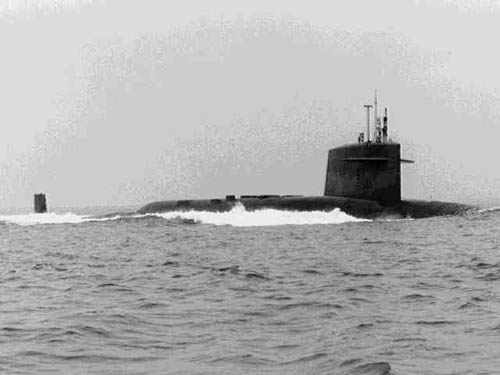Ethan Allen-class (SSBN-608)
Summary
| Origin country | 🇺🇸 United States |
| Category | Submarine |
| Subtype | Nuclear ballistic missile submarine |
| Manufacturer | General Dynamics Electric Boat, Newport News Shipbuilding |
| Year commissioned | 1961 |
| Units | SSBN-608 ETHAN ALLEN, SSBN-609 SAM HOUSTON, SSBN-610 THOMAS A. EDISON, SSBN-611 JOHN MARSHALL, SSBN-618 THOMAS JEFFERSON |
Description
The USS Ethan Allen (SSBN-608), named after the American Revolutionary War hero Ethan Allen, is notable for being the second vessel in the United States Navy to carry this distinction. As the lead ship of her class, the Ethan Allen was crucial in the development of U.S. naval capabilities during the Cold War era. The submarine was constructed by Electric Boat Corporation in Groton, Connecticut, and was set afloat on November 22, 1960, with the christening performed by Margaret Hitchcock (Sims) Hopkins, a direct descendant of Ethan Allen.
Designed specifically as a ballistic missile launch platform, the USS Ethan Allen represented a significant advancement in naval architecture. She was the first of her kind, following the George Washington class, which were modified attack submarines. Built with HY80 steel, the sub was equipped with a robust Ships Inertial Navigation System, providing high-level stability and accuracy essential for its missions.
At the time of its commissioning, the submarine was armed with Polaris A-2 ballistic missiles and Mark 16 torpedoes, showing advanced firepower for the period. The torpedo fire control system was notably a Mark 112 Mod 2. Throughout its operational history, the Ethan Allen underwent upgrades, first to its fire control system in 1965, adopting the Mark 80, and later, the missiles were updated to Polaris A-3Ts in the 1970s. Furthermore, improvements in torpedo technology led to the integration of Mark 37 and later Mark 48 torpedoes.
One of the most significant moments in the operational history of the USS Ethan Allen occurred on May 6, 1962, when the submarine carried out the only complete operational test of an American strategic missile. Named Frigate Bird, as part of Operation Dominic, a nuclear-armed Polaris missile was launched and successfully detonated above the South Pacific. This monumental event saw the warhead accurately strike its target and was overseen by high-ranking naval officers, including Admiral Levering Smith. USS Carbonero and USS Medregal were also involved in this crucial test.
With the introduction of the Ohio-class ballistic missile submarines and adherence to the SALT II treaty terms, the USS Ethan Allen had its missile tubes disabled, and the submarine's designation changed to an attack submarine on September 1, 1980. The vessel continued its service until March 31, 1983, when it was decommissioned and later stricken from the Naval Vessel Register. The submarine's final fate was to be recycled through the Nuclear Powered Ship-Submarine Recycling Program, completed in July 1999.
Culturally, the USS Ethan Allen's legacy was preserved in popular media, such as Tom Clancy's novel "The Hunt for Red October," where it was fictionalized as being destroyed to mislead the Russian Navy. This particular plot, however, did not make it into the subsequent film adaptation.
Technical specifications
| Ethan Allen | |
|---|---|
| Displacement | 7067 tons |
| Crew | 140 members |
| Width | 10.1 m (33.1 ft) |
| Length | 125.07 m (410.3 ft) |
| Max. depth | 400 m (1312.3 ft) |
| Propulsion | 1 General Electric S 5W reactor with a power of 25,000 hp - 1 propeller |
| Armament | 16 UGM-27 Polaris SLBMs + 4 533mm TLTs |
| Maximum speed | 16 knots |
| Max. speed submerged | 21 knots |
Photo of Ethan Allen class

Silhouette
